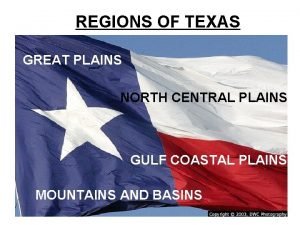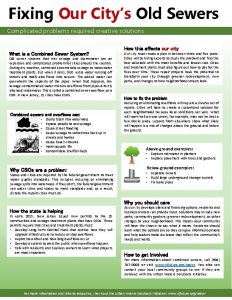Fixing Our Citys Old Sewers Your Waterways Your


- Slides: 2

Fixing Our City’s Old Sewers Your Waterways, Your Neighborhood, Your Money, Your Voice What is a Combined Sewer System? It is an older system that mixes sewage from households and businesses and stormwater flow from streets into one pipe. During dry weather, combined systems take all of that to wastewater treatment plants. But when it rains, that extra water running off streets and roofs combined with sewage overwhelms the capacity of the pipes. When that happens, the sewage-contaminated water mixture overflows from pipes directly into local waterways. This is called a combined sewer overflow, or a CSO. In New Jersey, 21 cities have combined sewer systems. Combined sewer overflows can: • • Dump trash into waterways Expose people to raw sewage Cause street flooding Cause sewage to back up in streets and homes • Cause beach closures • Harm aquatic life • Contaminate shellfish beds We must fix this States and cities are required by the federal government to meet water quality standards. This includes reducing or eliminating sewage spills into waterways. If they don’t, the federal government can order cities and states to meet standards and, as a result, dictate the repairs cities must do. To address the problem the New Jersey Department of Environmental Protection issued a permit in 2015 that requires communities with combined sewer systems to develop plans by 2020 to reduce sewage in our waterways, and to submit a report by July 2019 that selects the various alternatives they will evaluate for achieving this goal. Implementing these plans will cost billions of dollars over the next 30 years and will have significant effects on residents and business owners for generations to come. How do we fix this? Lessons from elsewhere show what likely will happen is a mix of changes above the ground and below the ground. Above-ground examples: • Capture rainwater in planters • Replace pavement with trees and gardens Below-ground examples: • Separate sewers • Build large underground storage tunnels • Fix leaky pipes We can fix this our way if we act now Reducing or eliminating overflows will require a diverse set of repairs. Cities will have to create a customized solution for each neighborhood because local conditions can vary. What will work well on one street, for example, may not be best a few blocks away. This is an important opportunity for us to determine how we want the problem fixed, before the federal government imposes costly requirements that may not be best for our city. Your voice is critical As our city develops plans and financing options, residents and business owners can provide input. Solutions may include new parks, community gardens, greener redevelopment, or other changes to your neighborhood. This means your community will have the chance to say what it wants. Residents should learn what the options are so they can give informed opinions and help leaders make decisions that reflect the community’s needs and wants. How to get involved For more information about combined sewers, call (609) 393 -0008 or visit Sewage. Free. NJ. org. You also can contact your local community groups to find out about local initiatives and resources. For more information and links to resources, check out the Sewage-Free Streets and Rivers Campaign at Sewage. Free. NJ. org

How can our city end CSOs? There is a diverse menu of solutions that can help reduce sewage overflows Experience from around the country shows us that cities are using a variety of ways, based on local conditions, to solve their CSO problems. The best solutions maximize community benefits and minimize costs. Here a few examples. Gray Infrastructure This below-the-ground infrastructure takes raw sewage and water to a sewage plant for treatment. Ways to fix or upgrade it include: Sewer line maintenance and repairs Cleaning pipes creates more room for sewage and stormwater. Fixing leaks reduces groundwater coming into pipes. Outfall disinfection This involves installing a device that releases a disinfectant into sewage before it overflows. Increasing capacity at sewage treatment plants This creates more room to treat sewage and stormwater at the plant so overflows happen less frequently. Underground storage tanks and tunnels These create a place for the stormwater and sewage to go until there’s room for it at the treatment plant. Sewer separation This makes two lines – one for sewage, one for stormwater, that bypasses the treatment plant – so the sewage plant is never overwhelmed when it rains. Education and Engagement Public notification of combined sewer overflows New Jersey cities are required to create a way to tell residents when sewage spills from overflow pipes. Public engagement CSO communities are required to get input from residents and business owners about which solutions they want. Green Infrastructure These above-the-ground methods mimic nature by capturing stormwater so it can be reused or it can trickle into the ground. Examples include: Rain barrels and cisterns These containers capture stormwater from roofs and save it for another use. Cisterns are large and collect from multiple roofs. Rain gardens During dry weather, these look like simple gardens. When it rains, stormwater flows in and seeps into the ground. Pervious pavement This type of paving material allows water to seep in rather than rush off into sewers. It can be used for many paved areas. Green and blue roofs Blue roofs are designed to retain and slowly release water after a storm. Green roofs are planted with grass and other plants. Green streets When cities make major repairs to streets, they can include areas with grass and trees to absorb stormwater. Policies and Programs Stormwater requirements on new development Cities can require new and redeveloped buildings keep stormwater on site to infiltrate into the ground or be reused. Planning for the future Cities can consider designing stormwater infrastructure for future conditions, including effects from climate change. Collaborate with neighboring communities and sewage plants Cities can work with neighbors to develop plans and share costs. Finance Sewer rates Rates can be increased to pay for upgrades. They can be designed so lower-income households can afford their sewer bills. Stormwater fees Many cities around the country use a fee that is calculated by how much area on a parcel does not absorb or retain water. Innovative financing This includes incentives and grant programs for private property owners, as well as public/private partnerships. For more information and links to resources, check out the Sewage-Free Streets and Rivers Campaign at Sewage. Free. NJ. org



